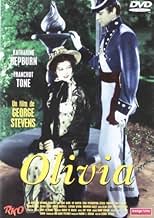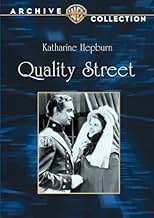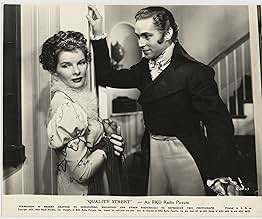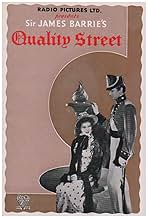NOTE IMDb
6,2/10
1,4 k
MA NOTE
Ajouter une intrigue dans votre langueIn the 1810s, an old maid poses as her own niece in order to teach her onetime beau a lesson.In the 1810s, an old maid poses as her own niece in order to teach her onetime beau a lesson.In the 1810s, an old maid poses as her own niece in order to teach her onetime beau a lesson.
- Réalisation
- Scénario
- Casting principal
- Nommé pour 1 Oscar
- 3 victoires et 1 nomination au total
Sherwood Bailey
- William Smith
- (non crédité)
William Bakewell
- Lt. Spicer
- (non crédité)
Joan Fontaine
- Charlotte Parratt
- (non crédité)
Helena Grant
- Fanny Willoughby
- (non crédité)
Bonita Granville
- Isabella
- (non crédité)
Carmencita Johnson
- Student
- (non crédité)
Payne B. Johnson
- School Boy
- (non crédité)
Darwood Kaye
- Student
- (non crédité)
Florence Lake
- Henrietta Turnbull
- (non crédité)
Helen Lynn
- Girl
- (non crédité)
Lydia McKim
- Schoolgirl
- (non crédité)
Clifford Severn
- Arthur, a Student
- (non crédité)
Avis à la une
Quality Street is a contrived romance, with a small cast, on a set that looks like a play stage, with few visual impacts and in B&W. So, why did we enjoy it so much? The cast, down to the overplayed smaller parts, all does a great job. The ensemble cast brings spirit to even the small parts, the dialogue is clever, and the asides and glances make it fun. We particularly enjoyed the set and period behaviors as great insights on life in the early 19th century. Hollywood did a great job in establishing this period essence through effective use of hints and props. If you like Hepburn, you will enjoy this moral story, with feminine strength in an unforgiving society. Worth a relook!
QUALITY STREET (RKO Radio, 1937) directed by George Stevens, stars Katharine Hepburn in her third costume movie in a row (following 1936 releases of "Mary of Scotland and "A Woman Rebels"), and her first to be classified a comedy. Taken from the old stage play by Sir James M. Barrie, the same author whose work was used for Hepburn's 1934 release of THE LITTLE MINISTER, places the now legendary actress for the first of many times in the role of a spinster, but in this case not entirely throughout its 84 minutes.
The setting: "1805 England. Quality Street where a gentleman passerby is an event." Other than an event, Quality Street is also a location of homes where spinster women peep through their window curtains watching everything that goes on. The story introduces Susan Throssel (Fay Bainter), an old maid, hosting her spinster guests, sisters Mary (Estelle Winwood) and Fanny Willoughby (Helena Grant), and Henrietta Turnball (Florence Lake) as they crochet while one reads a book aloud. Phoebe (Katharine Hepburn), Susan's younger sister, arrives with the news of having met a certain individual dashing young man who's finds her fascinating, and will soon be arriving to tell her some important news. Thinking the young man to be interested in proposing marriage to Phoebe, Susan, once engaged to William, a Naval officer, offers her sister a wedding gown she never used. When Doctor Valentine Brown (Franchot Tone) comes to call, he surprises Phoebe with the news about enlisting in the Napoleonic war, stirring up bitter disappointment for her, especially after watching him marching off with the other enlistments. Ten years later, Phoebe and Susan, now spinster teachers at "The Misses Throssel School for Boys and Girls," find the soldiers returning home from war. Upon his arrival, Valentine becomes disappointed to find the once vibrant and beautiful Phoebe, now 30, looking old and tired. Noticing how the other ensigns (William Bakewell and Roland Varno) are wooing the young and silly Charlotte Parratt (Joan Fontaine), Phoebe abandons her drab existence by applying herself with new clothes and hair style. Phoebe's youthful appearance immediately attracts Valentine attention, who fails to recognize her as the girl he once loved. Passing herself off as her visiting flirtatious niece, Olivia, Phoebe not only becomes in Valentine's eyes, but after escorting her to the ball, attracts the attention of Charlotte's suitors as well. Problems arrive as the snoopy Henrietta and the Willoughby sisters suspect both Phoebe and "Livvy" to be one of the same, forcing Phoebe to wonder how long she'll be able to go on with her masquerade without arousing Valentine's suspicion and possibly losing him in the process.
Though the masquerading idea of woman attempting to fool the man she loves by becoming another identity is nothing new, it always seems to go well, especially wondering what will result for its climax. In spite the fact that QUALITY STREET was used as a basis of a silent 1927 MGM comedy starring Marion Davies, Conrad Nagel and Helen Jerome Eddy in the Hepburn, Tone and Bainter roles, the 1937 remake reportedly didn't do as well as the Davies original possibly due to Hepburn's current theatrical failures that labeled her at the time as "box-office poison." Even though QUALITY STREET somewhat resembles Jane Austen's PRIDE AND PREJUDICE (successfully filmed by MGM in 1940) by way of locale, costume setting and spinster characters of the 19th century, the film itself is quite quaint and lavish scale with fine underscoring credited to Roy Webb. Of the supporting players, there's the comic relief of Eric Blore as a recruiting sergeant with a constant blink of an eye towards Patty (Cora Witherspoon); Fay Bainter providing character interest as both sympathetic spinster and mousy schoolteacher afraid of one of her students, a tall bully by the name of William Smith (Sherwood Bailey). It's also interesting spotting Estelle Winwood, a familiar face in many TV shows of the 1960s and 70s very early in her career, along with future Academy Award winner, Joan Fontaine, in two brief scenes, one with Hepburn.
Regardless of its reputation that caused QUALITY STREET to be seldom revived on commercial television back in the 1960s and 70s, the film itself began to surface more frequently later on with revivals on public television, home video (1980s-90s) and later DVD, cable television (American Movie Classics prior to 1998) and Turner Classic Movies. Alternative versions have usually been found through its opening credits: Title card Movietime" used in place of RKO Radio logo commonly shown in sixties and seventies; a brief glimpse insertion from an early RKO title, LET'S TRY AGAIN (1934) before the actual QUALITY STREET title fills the screen, or the restored theatrical opening on TCM. For anyone unfamiliar with both Hepburn and QUALITY STREET, it's worth seeing through once, at least out of curiosity (***)
The setting: "1805 England. Quality Street where a gentleman passerby is an event." Other than an event, Quality Street is also a location of homes where spinster women peep through their window curtains watching everything that goes on. The story introduces Susan Throssel (Fay Bainter), an old maid, hosting her spinster guests, sisters Mary (Estelle Winwood) and Fanny Willoughby (Helena Grant), and Henrietta Turnball (Florence Lake) as they crochet while one reads a book aloud. Phoebe (Katharine Hepburn), Susan's younger sister, arrives with the news of having met a certain individual dashing young man who's finds her fascinating, and will soon be arriving to tell her some important news. Thinking the young man to be interested in proposing marriage to Phoebe, Susan, once engaged to William, a Naval officer, offers her sister a wedding gown she never used. When Doctor Valentine Brown (Franchot Tone) comes to call, he surprises Phoebe with the news about enlisting in the Napoleonic war, stirring up bitter disappointment for her, especially after watching him marching off with the other enlistments. Ten years later, Phoebe and Susan, now spinster teachers at "The Misses Throssel School for Boys and Girls," find the soldiers returning home from war. Upon his arrival, Valentine becomes disappointed to find the once vibrant and beautiful Phoebe, now 30, looking old and tired. Noticing how the other ensigns (William Bakewell and Roland Varno) are wooing the young and silly Charlotte Parratt (Joan Fontaine), Phoebe abandons her drab existence by applying herself with new clothes and hair style. Phoebe's youthful appearance immediately attracts Valentine attention, who fails to recognize her as the girl he once loved. Passing herself off as her visiting flirtatious niece, Olivia, Phoebe not only becomes in Valentine's eyes, but after escorting her to the ball, attracts the attention of Charlotte's suitors as well. Problems arrive as the snoopy Henrietta and the Willoughby sisters suspect both Phoebe and "Livvy" to be one of the same, forcing Phoebe to wonder how long she'll be able to go on with her masquerade without arousing Valentine's suspicion and possibly losing him in the process.
Though the masquerading idea of woman attempting to fool the man she loves by becoming another identity is nothing new, it always seems to go well, especially wondering what will result for its climax. In spite the fact that QUALITY STREET was used as a basis of a silent 1927 MGM comedy starring Marion Davies, Conrad Nagel and Helen Jerome Eddy in the Hepburn, Tone and Bainter roles, the 1937 remake reportedly didn't do as well as the Davies original possibly due to Hepburn's current theatrical failures that labeled her at the time as "box-office poison." Even though QUALITY STREET somewhat resembles Jane Austen's PRIDE AND PREJUDICE (successfully filmed by MGM in 1940) by way of locale, costume setting and spinster characters of the 19th century, the film itself is quite quaint and lavish scale with fine underscoring credited to Roy Webb. Of the supporting players, there's the comic relief of Eric Blore as a recruiting sergeant with a constant blink of an eye towards Patty (Cora Witherspoon); Fay Bainter providing character interest as both sympathetic spinster and mousy schoolteacher afraid of one of her students, a tall bully by the name of William Smith (Sherwood Bailey). It's also interesting spotting Estelle Winwood, a familiar face in many TV shows of the 1960s and 70s very early in her career, along with future Academy Award winner, Joan Fontaine, in two brief scenes, one with Hepburn.
Regardless of its reputation that caused QUALITY STREET to be seldom revived on commercial television back in the 1960s and 70s, the film itself began to surface more frequently later on with revivals on public television, home video (1980s-90s) and later DVD, cable television (American Movie Classics prior to 1998) and Turner Classic Movies. Alternative versions have usually been found through its opening credits: Title card Movietime" used in place of RKO Radio logo commonly shown in sixties and seventies; a brief glimpse insertion from an early RKO title, LET'S TRY AGAIN (1934) before the actual QUALITY STREET title fills the screen, or the restored theatrical opening on TCM. For anyone unfamiliar with both Hepburn and QUALITY STREET, it's worth seeing through once, at least out of curiosity (***)
This is a gem!--IF you like stories set in this time period to begin with. IF you like the more sentimental acting style prevalent in the 1930's. And probably IF you're female.
This has some resonance with Jane Austen's Persuasion. For me, it felt as if I'd found a new Georgette Heyer story, and on film! This is set in the Regency period in England. It is both romantic and comedic.
Katherine Hepburn gives another great performance, similar to her Jo March in Little Women. I don't find her acting over the top at all. Franchot Tone is a good foil for her--not a great actor, but pretty hunky. Additionally, it has a lovely cast full of the kind of character actors you see in films like the Greer Garson Pride and Prejudice. In this case, it's Fay Bainter, Estelle Winwood, and other notables giving the film a fey charm.
This has some resonance with Jane Austen's Persuasion. For me, it felt as if I'd found a new Georgette Heyer story, and on film! This is set in the Regency period in England. It is both romantic and comedic.
Katherine Hepburn gives another great performance, similar to her Jo March in Little Women. I don't find her acting over the top at all. Franchot Tone is a good foil for her--not a great actor, but pretty hunky. Additionally, it has a lovely cast full of the kind of character actors you see in films like the Greer Garson Pride and Prejudice. In this case, it's Fay Bainter, Estelle Winwood, and other notables giving the film a fey charm.
...Well, this film is chock full of boisterous shyness! Look at us we are so shy! And it gets very annoying in short order. It's about a street in England in 1805 - Quality Street - that has nobody but spinsters living there. No explanation of this is ever given. Every time a man appears all of the curtains part, and the residents all stare. In fact, anytime somebody new appears on the street they all stare.
The residents we are introduced to are ridiculously introverted and repressed, yet they are also passive aggressive and spend their time being nosey about others since they have no real lives of their own. The Throssel sisters are two people living on this street, young Phoebe (Kate Hepburn) and her older sister, Susan (Fay Bainter). Phoebe has some hope of being taken away from all of this when she meets a young physician, Valentine Brown (Franchot Tone), who seems interested in her, but when he comes to her house for a big announcement, it is that he has joined the army to fight Napoleon.
Phoebe declares that Brown is the one she loves, she is not interested in entertaining any other suitors, and then she throws herself into the work of running a school with her sister. Ten years pass and although Phoebe is only 30, she looks much older than that. Thus when Val (Valentine) returns from war, he is visibly shaken by her changed and wilted appearance and seems to recoil. After he leaves, Phoebe shakes down her hair, puts on an ornate gown, and begins to prance around as though she is 20 again. In the process, she seems to transform back into her 20 year old self. It's rather ridiculous - kind of like the 60s movie where a secretary takes off her glasses, shakes down her hair and is suddenly a go-go dancer, but I digress.
The problem is that Val returns suddenly and sees her like this and Phoebe is embarrassed by her behavior, so a servant identifies her as Livy, Phoebe's niece. Val is entranced, and now Phoebe is forced to keep up the ruse of being two people. The complicating factor is that the existence of this relative that nobody ever knew existed is noticed by the nosey neighbors, they don't believe that Livy is a real person, and they set out to prove that Livy and Phoebe are one in the same. Complications ensue.
Besides belaboring the issue of the residents of Quality Street being repressed but nosey, there are just no real likeable characters here. Phoebe should have cleared up this matter from the start but she doesn't, and Val is clueless as to what he means to Phoebe and seems to forget what time and age do to people. It does get pretty amusing in the last act, but it's a tough hard slog to get to that last act.
The residents we are introduced to are ridiculously introverted and repressed, yet they are also passive aggressive and spend their time being nosey about others since they have no real lives of their own. The Throssel sisters are two people living on this street, young Phoebe (Kate Hepburn) and her older sister, Susan (Fay Bainter). Phoebe has some hope of being taken away from all of this when she meets a young physician, Valentine Brown (Franchot Tone), who seems interested in her, but when he comes to her house for a big announcement, it is that he has joined the army to fight Napoleon.
Phoebe declares that Brown is the one she loves, she is not interested in entertaining any other suitors, and then she throws herself into the work of running a school with her sister. Ten years pass and although Phoebe is only 30, she looks much older than that. Thus when Val (Valentine) returns from war, he is visibly shaken by her changed and wilted appearance and seems to recoil. After he leaves, Phoebe shakes down her hair, puts on an ornate gown, and begins to prance around as though she is 20 again. In the process, she seems to transform back into her 20 year old self. It's rather ridiculous - kind of like the 60s movie where a secretary takes off her glasses, shakes down her hair and is suddenly a go-go dancer, but I digress.
The problem is that Val returns suddenly and sees her like this and Phoebe is embarrassed by her behavior, so a servant identifies her as Livy, Phoebe's niece. Val is entranced, and now Phoebe is forced to keep up the ruse of being two people. The complicating factor is that the existence of this relative that nobody ever knew existed is noticed by the nosey neighbors, they don't believe that Livy is a real person, and they set out to prove that Livy and Phoebe are one in the same. Complications ensue.
Besides belaboring the issue of the residents of Quality Street being repressed but nosey, there are just no real likeable characters here. Phoebe should have cleared up this matter from the start but she doesn't, and Val is clueless as to what he means to Phoebe and seems to forget what time and age do to people. It does get pretty amusing in the last act, but it's a tough hard slog to get to that last act.
I was about to go to bed one night and was watching a movie on TCM. The movie I was watching had just ended and Quality Street started to play. I was so charmed by this movie that I had to stay up quite late and finish watching it. I just couldn't make myself push the off button on my remote:) Katharine is quite charming as Phoebe and plays her niece quite well too. I honestly don't think Katharine looks too old, as other reviews have stated. Franchot Tone is very handsome as the gullible soldier. A good supporting cast as well. It is a light, entertaining romantic comedy. Just as long as you think this while the movie plays, it won't disappoint.
Le saviez-vous
- AnecdotesThe Nestle produced chocolates "Quality Street" were named after J. M Barrie's play by their original manufacturer Mackintosh in 1936.
- GaffesWhen Phoebe and Susan are talking about Mr. B., Phoebe is on a chair and Susan is sitting on a sofa a certain distance near a bonnet. But on the following cuts, Susan's sitting position keeps changing so that she is gets closer and closer to the bonnet.
- Citations
Mary Willoughby: [Goes to the window and looks out] It's that impertinent recruiting sergeant. I passed him on the street yesterday. He closed one of his eyes at me, then quickly opened it again.
[She demonstrates to the other ladies in the room]
Mary Willoughby: I knew what he meant.
[She looks out again and sees the recruiting officer wink at her. She quickly closes the window curtain]
- Crédits fousOpening card:
1805 England Quality Street Where a gentleman passerby is an event.
- ConnexionsFeatured in George Stevens: A Filmmaker's Journey (1984)
Meilleurs choix
Connectez-vous pour évaluer et suivre la liste de favoris afin de recevoir des recommandations personnalisées
- How long is Quality Street?Alimenté par Alexa
Détails
- Durée
- 1h 23min(83 min)
- Couleur
- Rapport de forme
- 1.37 : 1
Contribuer à cette page
Suggérer une modification ou ajouter du contenu manquant

































